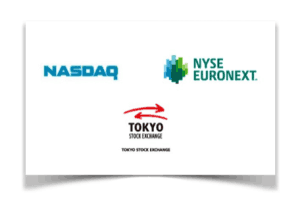Greg Anderson posted an interesting question in the beginning of 2013: “Should we celebrate equity crowdfunding at the first investment or first exit?”. More and more savvy (crowdfunding) investors like Nelson Gray and Daniel Isenberg are leaning towards the latter, pointing out the problems of securing a decent exit. There have been several success cases on our equity crowdfunding platform, two of them exemplary. Why haven’t investors cashed in yet?
Examples of equity crowdfunding succes: Sellanapp & Frebble
 Sellanapp is an equity crowdfunding platform itself, specialized in App-creation. App-creators get the chance to design their app, have it crowdfunded, developed, published and finally receive income from the Apple app-store. In return the investors get a share of the revenue as long as the app is in the store.
Sellanapp is an equity crowdfunding platform itself, specialized in App-creation. App-creators get the chance to design their app, have it crowdfunded, developed, published and finally receive income from the Apple app-store. In return the investors get a share of the revenue as long as the app is in the store.
Sellanapp got their first round of funding via our platform a few years back. The offer? An astounding 53% of the available shares for EUR 150,000 (USD 205,000) in capital: a valuation of EUR 283,019 (USD 387,000). One year later, 10 apps had started their development phase (meaning they got funded), two apps went to the app-store, nine apps were ready to get funded, the website had been redesigned and unique visitors numbers were rising.
Sellanapp started a second round, offering 3.3% of the shares for EUR 100,000 (USD 137,000), meaning the new valuation was 10 times as high: EUR 2.791.406 (USD 3.8 million). A lucky shot for investors? Maybe, but in the same year Holland Haptics’ “Frebble” (an online haptic touch device) went from a EUR 250,000 (USD 342,000) valuation to a EUR 2.5 million (USD 3.42 million) valuation. Even if the valuation had only doubled (of which I’m sure there are many more cases to be found), investors would’ve considered it a success. And that’s where things go wrong.
It Doesn’t Mean a Thing When You Can’t Access the Money
It’s great the invested EUR 1,000 now has become EUR 10,000, but it doesn’t mean a thing when you can’t access that money. True, an exit from a startup company after a year might be soon, but with these kinds of ROI’s in mind and possibly prospected dilutions, you might want to reconsider staying in this startup for too long. So why hasn’t any of the investors exited these companies?
 Entrepreneurs don’t care about an exit
Entrepreneurs don’t care about an exit
Though certainly not the case in these two examples, there have been suggestions that entrepreneurs simply don’t care about what’s good for their investors, saying.
“I love crowdfunding: it is cheap money for me. I know it is not good for the investors.”.
I’m happy to say I haven’t heard that one myself, but it doesn’t mean there aren’t more people with a similar take on crowdfunding too. And not caring usually means not knowing, as a good exit is valuable for entrepreneurs as well.
Investors don’t inform themselves about a good exit
Of maybe they would if they know how it would impact their bank account. Though there have been some questions from informed shareholders, the majority of the investors haven’t considered the exit beforehand. This is a problem because it shows most equity crowdfunders don’t understand the fundamentals of investing. It might also indicate they see investing more as a lottery ticket: “If it turns out well I might get lucky”. That is not the way sustainable value creation is being initiated between the entrepreneur and the investors, leaving a gap where the win-win situation should be.
Large group of people
 Crowdfunding involves large groups of investors that would have to go to the notary or other legal institutions to sell their shares. A costly process which in the case of a decent exit usually involves an expensive due diligence. So much for your ROI. In addition, you’d have to repeat that for some 150 shareholders, elongating the duration of the exit and post phoning the date on which investors get the actual money.
Crowdfunding involves large groups of investors that would have to go to the notary or other legal institutions to sell their shares. A costly process which in the case of a decent exit usually involves an expensive due diligence. So much for your ROI. In addition, you’d have to repeat that for some 150 shareholders, elongating the duration of the exit and post phoning the date on which investors get the actual money.
Though it’s currently possible to bundle the investors into a cooperation that counts as one shareholders within a company (so you’ll only go through the buy-in process only once), a similar structure is still under development. It’s possible, but only if the entire group of investors decides to exit together. Though the Shareholder agreement covers this decision making process, the trajectory still isn’t as smooth as it should be. The answer to secure single investor exits? Create a secondary market place.
How to get there?
There is an interesting guest post on Venture Beat, explaining how such a market place should evolve. In summary, government should encourage and (legally) support the creation of these market places, which could be portal specific or an independent site offering different shares from different platforms.
 Though the latter is preferable, we’ve seen the trouble of cross-selling “real” shares between already existing market places such as the NASDAQ, Tokyo Stock Exchance and the Euronext: there are a lot of reasons each geographic region feels the need to create its’ own exchange. Transfer those motivations to the equity industry and you’ll get a financial mess that might take years to figure out.
Though the latter is preferable, we’ve seen the trouble of cross-selling “real” shares between already existing market places such as the NASDAQ, Tokyo Stock Exchance and the Euronext: there are a lot of reasons each geographic region feels the need to create its’ own exchange. Transfer those motivations to the equity industry and you’ll get a financial mess that might take years to figure out.
Hoping group-like exits for equity investors could dramatically lower the interest experienced investors (that should serve as an example for the rest of the investors) have in equity crowdfunding. That means the industry’s full potential might never be reached or that the industry growth slows down, which could have an impact on the (amount of) companies receiving capital. Instead of waiting for the first steps of equity crowdfunding to be developed (the option to safely buy in on SME’s), we should already draft versions of secondary markets so that when the time comes an exit would benefit the entrepreneur and the investors, we can actually provide a valuable exit.
______________________________
 Ludwine Dekker has been coaching entrepreneurs in executing their digital fund raising for three years. As a digital marketing specialist, she specializes in entrepreneurship, technology and fund-raising. As a campaign manager at Symbid she strategically manages the entrepreneur’s campaigns and requirements, organizes pitch events, frequently writes for several platforms, and gives workshops.
Ludwine Dekker has been coaching entrepreneurs in executing their digital fund raising for three years. As a digital marketing specialist, she specializes in entrepreneurship, technology and fund-raising. As a campaign manager at Symbid she strategically manages the entrepreneur’s campaigns and requirements, organizes pitch events, frequently writes for several platforms, and gives workshops.



